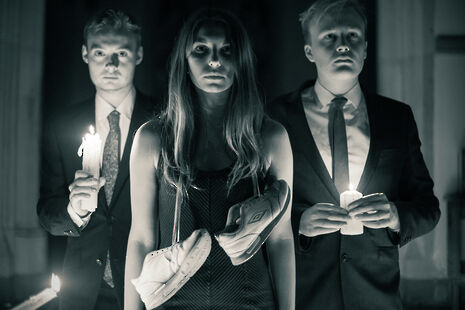Review: The Duchess of Malfi
The opening night showed potential, but left room for improvement

The point of ADC mainshows that simply regurgitate normal commercial expectations of a play, for the purpose of the enjoyment of participants, is questionable. This is especially relevant at a university where, more so than many other student bodies, the right production – and enough business acumen – would be well placed to make ripples across Britain's mainstream theatre landscape. Being of this opinion, I was very pleased to see The Duchess Of Malfi’s innovative set as I awaited the performance last night.
Reams of cloudy white duvets cascade down the towered rostra either side of the back of Jack Parham’s well-engineered set framework . The multitude of elegant lamps that hung in a cluster from the ceiling, suspended like electric stars above the stage, reminded me of Adrian Noble’s heavily YouTubed 1994 RSC production of A Midsummer Night’s Dream. The emphasis of that production was to strip back Shakespeare’s play-world to a series of doors, expansive space, and lighting – creating an open, timeless, play space befitting a dream. As I sat down last night it seemed this Marlowe Society production might be making nods in the same direction . This type of transposition of Webster texts – perhaps because they’re produced much less than Shakespeare – is a more individual approach.
As the production began, an atmosphere of playful experiment was reinforced. A mass chorus spreads across the stage in pairs. Staring into one another's eyes, they express a claustrophobic sexual tension: fiddling with one another’s hair, touching hands, and holding, fixedly, one another’s gaze. This felt very inspired by Frantic Assembly. It was a signal this production was going to continue to attempt bold experiment – but perhaps within a framework of direct references to other well known mainstream inventors. Indeed, a similar piece of staging was very successfully used in the opening of Jack Eastwood’s Under Milk Wood at Trinity earlier this year. However, while good intentions were clear, cracks in production values were beginning to show at this early stage. From the mismatched own clothes of chorus members to the patchily staggered placement of individuals within the scene, it was beginning to look more amateurish and under-rehearsed than the many productions I have been wowed by at the ADC.
Centrally, here, I criticise the execution of the production as a whole. There were lots of individual elements that could’ve easily been components of a smoothly running machine. The decision to have all action take place towards the front of the stage as the chorus looked on from behind was a thoughtful meta-theatrical choice. Joe Sefton was a professional Antonio with an assertive stage presence and naturalistic physicality. Isobel Laidler’s Cariola presented a screen and stage ready actor – with a casting type somewhere between Claire Foy and Scarlett Johansson. Other casting choices were more confusing. The Duchess’s characterisation felt a little under-optimised and two dimensional. The performance showed potential with some good comic timing – but could have benefited from a more mature, wise, femme-fatale demeanour.
Decisions with costume, too, were slightly off beat and lacked coherence. Converses made an appearance on one character – while another looked ready for a production of Jane Eyre. To give the play a timeless setting was an interesting choice but the time and culture that it was set within should have been made far clearer . At times it looked like seasons of Doctor Who and Downton Abbey were confusedly filming on the same set, while a disgruntled production crew slept at the back.
Lines were sometimes lost, mumbled, and delivered to the back of the stage at times while diction could be poor. I would put this down, largely, to it being an opening night for a busy cast – and will be something that will improve throughout the week.
There were moments of the production that were emotionally engaging, and, for the range of ideas it explores, it is worth a watch. However, on its opening night, the quality of this piece was more fragmented than might be expected considering the platforms on which it stands
 News / Students clash with right-wing activist Charlie Kirk at Union20 May 2025
News / Students clash with right-wing activist Charlie Kirk at Union20 May 2025 News / Clare Hall spent over £21,000 on lawyers to warn against ‘intrusive’ Cambridge busway plans23 May 2025
News / Clare Hall spent over £21,000 on lawyers to warn against ‘intrusive’ Cambridge busway plans23 May 2025 Comment / Are college-mandated quiet periods more harm than good?21 May 2025
Comment / Are college-mandated quiet periods more harm than good?21 May 2025 News / £40m infrastructure upgrades for Cambridge railway completed20 May 2025
News / £40m infrastructure upgrades for Cambridge railway completed20 May 2025 Theatre / MESSIAH: a gaze at the irony of modern politics22 May 2025
Theatre / MESSIAH: a gaze at the irony of modern politics22 May 2025





